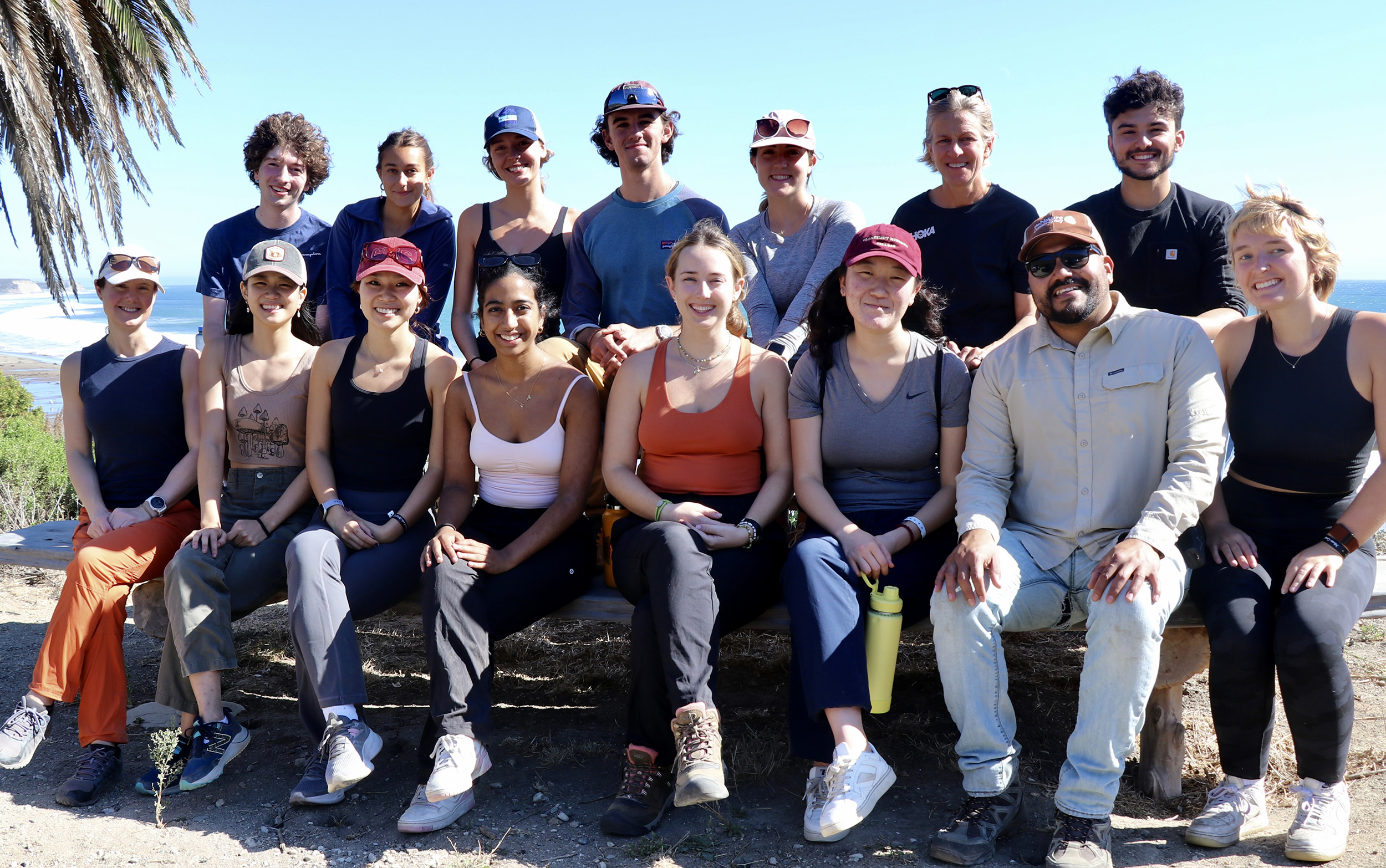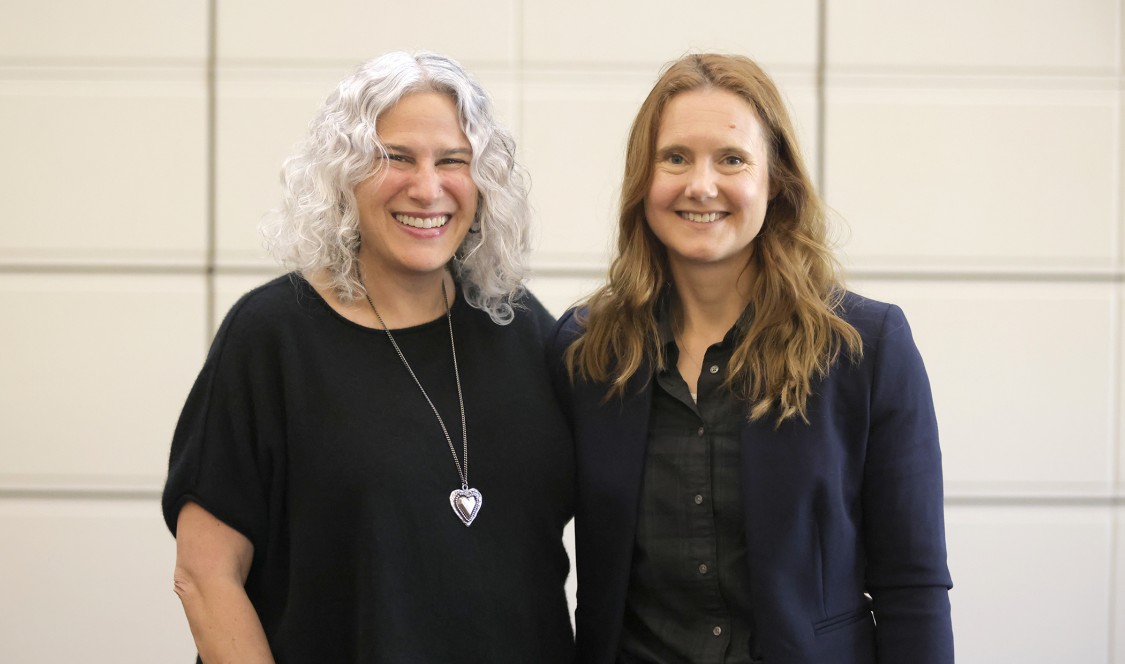Branwen Williams installation ceremony
Branwen Williams was installed as the George R. Roberts Professor of Integrated Sciences: Environmental Science on Nov. 14 in a ceremony at the Athenaeum led by Heather Antecol, Vice President of Academic Affairs and Dean of the Faculty, who presented Williams with a special medallion.
In her remarks, Antecol shared profound gratitude for the support of George R. Roberts ’66 P’93, a CMC trustee since 1982, and a life member of the Roberts Environmental Center Advisory Board. In addition to establishing the George R. Roberts Professor of Integrated Sciences: Environmental Science, “Mr. Roberts and his family have demonstrated exceptional generosity to CMC in support of student financial aid, public art and campus facilities, including the Roberts Pavilion,” Antecol said.
In addition, Roberts established the Roberts Environmental Center, the George R. Roberts Faculty Leadership Initiative, and most recently, the Roberts Integrated Sciences and Computational Matching Initiative. In 2022, Roberts made a $140 million pledge to CMC to expand and develop the eastern half of CMC’s campus, which is being named Roberts Campus in his honor.
For Professor Branwen Williams, sparking a student’s interest in the sciences is one of the most gratifying aspects of teaching at Claremont McKenna College.
The spark can be inspired in the classroom, the lab, or out in the field conducting research. “There are those for whom that spark is life-changing. And that’s amazing,” Williams explained, recalling how one of her students, who authored one of her first published papers with Williams, was inspired to pursue a PhD in the sciences. She recently defended her dissertation, with Williams proudly looking on.
“But then I’ve also had students who are not scientists — they go into business or finance— who are inspired to stop and pause, and now they just look at our world a little bit differently,” she said. “That spark is not life-changing for them, but I do think it gives them a different appreciation.
“I can see it when we take students just across the street to the 86-acre Barnard Field Station (operated by the Claremont Consortium), where they get an idea of what Southern California would look like without urbanization,” she continued. “They learn how to recognize what has been disturbed by humans, how the area recovers, or returns. Or does it return? Have the soil microbes changed, which means the original plants will never grow back? And we also do a mapping exercise, and just observe. And then we can go back later and do hypothesis testing.”
And now, Williams who has recently taken on new leadership roles on campus — as the director of the Roberts Environmental Center (REC), as well as a faculty member with the recently launched Kravis Department of Integrated Sciences (KDIS) — is poised to inspire the entire CMC community to find their own spark, as well as develop strategies to mitigate climate change.
“CMC can be a leader in getting to carbon neutrality in coming decades,” Williams said during a recent ceremony at the Athenaeum, where she was installed as the George R. Roberts Professor of Integrated Sciences: Environmental Science (see sidebar). In her speech, “Inhabiting Earth: Stories from a Climate Scientist,” Williams shared an optimistic vision for how CMCers can shape the planet’s future.
Williams’ research seeks to understand the response of our environment to human activities, and she uses biological materials such as corals and algae as tools because they capture environmental characteristics. A National Geographic Explorer, her work is funded by the National Science Foundation and the National Oceanic Atmospheric Administration. She joined the Claremont Colleges in 2011, and has served as the co-director of EnviroLab, a 5C program funded by the Henry Luce Foundation, focused on using community engagement and a multidisciplinary lens to understand environmental issues.
In recognition of Williams' scholarship, the National Science Foundation recently honored her with a mid-career Advancement Award. This is the second year of a new NSF program that is filling a critical gap in support of mid-career faculty. The award will enable Williams to launch her KDIS research program, and will connect the Roberts Environmental Center with colleagues at UC Irvine as collaborators to learn new techniques that will further enhance our understanding of climate science.
Williams believes the CMC community is ideally positioned to lead climate progress. “At CMC, we have these strengths — in economics, business, finance, and in the natural sciences — and so, thinking about how we can use the REC and KDIS to move forward, and putting CMC out there as a place that’s doing this really, really important work, that’s something that I’m personally very invested in,” she said.
The principal goal of the REC is to involve students in real-world environmental issues and to train them to analyze these issues from as broad a perspective as possible, taking science, economics, and policy into consideration. In addition, the REC strives to cultivate environmental leadership within its student body.
The “really important work” includes continuing to build upon the REC’s efforts over the past decade, such as a project with a high school in Pomona “to look at how to mitigate urban heat island effect.” This effect, Williams explained is “when you have more buildings and less trees, which can cause localized warming.”
Williams also cited the REC’s partnership with The Nature Conservancy to develop environmental education programs, and provide the opportunity for the REC Fellows “to spend time in nature and see the way that nature is dynamic and interconnected and how we play a role in that.”

As part of this partnership, Williams and the REC Fellows got the rare opportunity to visit a pristine beach location near Santa Barbara, The Nature Conservancy’s Jack and Laura Dangermond Preserve.
“Taking students off campus and into the environment is invaluable,” Williams said, not just for research purposes, but – in this case—to help develop an environmental education curriculum “for younger kids, particularly in areas that don’t have the ability to go out and explore nature on their own, so that we can build stewards for our environment going forward.”
Williams also shared that she’s excited about a bridge she’s creating between the sciences and the humanities. “We’re working with a glaciologist, myself, and a high school teacher, with two REC interns to build a high school curriculum to educate students on climate science, so that they can write climate fiction stories in their English class about how society might live under future climate scenarios.”
Building curricular and co-curricular programming about Earth is where Williams is focusing her KDIS efforts as the new department is framed around three major themes: Human health, the brain, and our planet. “I think it’s a really forward-looking perspective, because it’s not just to train more scientists,” she said. “What we want to do is create a literacy for all of our CMC students, so that our students, who are going into other careers, such as government, or into industry, will be able to keep [what they learn] in the back of their mind, and shift society, shift our actions, to really cause change.
“And I think KDIS, with a focus on our non-science majors— as well as our science majors— is a really innovative, important way to do that.”
Members of the Claremont McKenna College community have the opportunity to discover the wonders of Antarctica with Professor Branwen Williams aboard the National Geographic Explorer. In conjunction with Lindblad Expeditions, CMC travelers will depart on January 8, 2025, on an 11-day trek.
The voyage will launch into a unique world of marine wildlife, frozen landscapes, and incredible geological formations. Voyagers will spot ethereal albatross and other giant pelagic birds that glide as well as the telltale spout of orcas and acrobatic pods of leaping dolphins off the deck. Approaching the Antarctic islands, participants will float into an ice desert of crystalline air and frozen seas, welcomed by penguins. Staggering in its variety of forms, the visual beauty of polar ice makes every Antarctic explorer vow to return.
Full details of the trip, including pricing and cabin availability, may be found at CMC in Antarctica or call 949-930-9288 or email [email protected].

